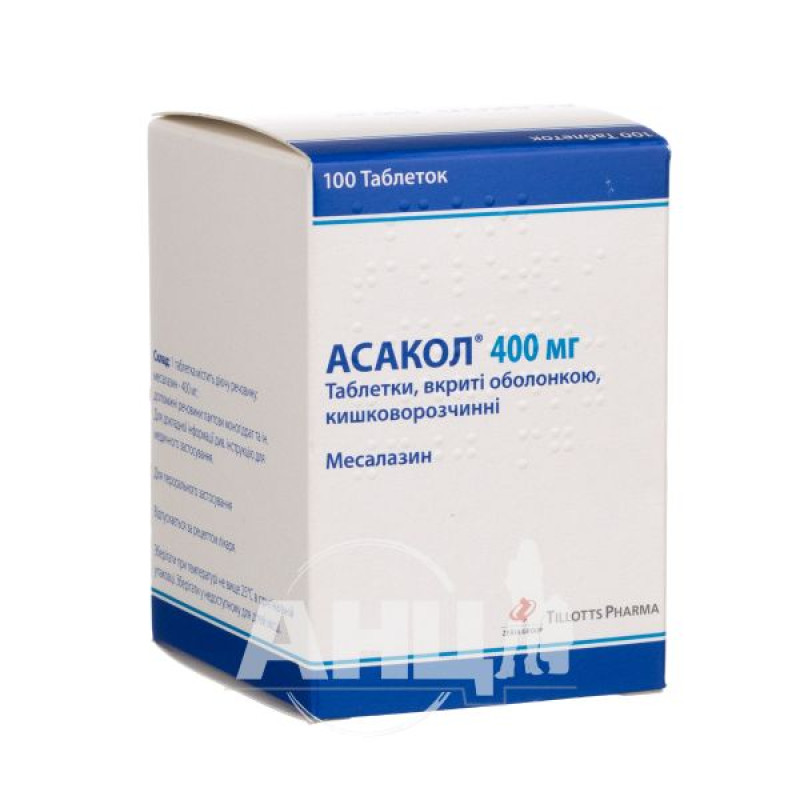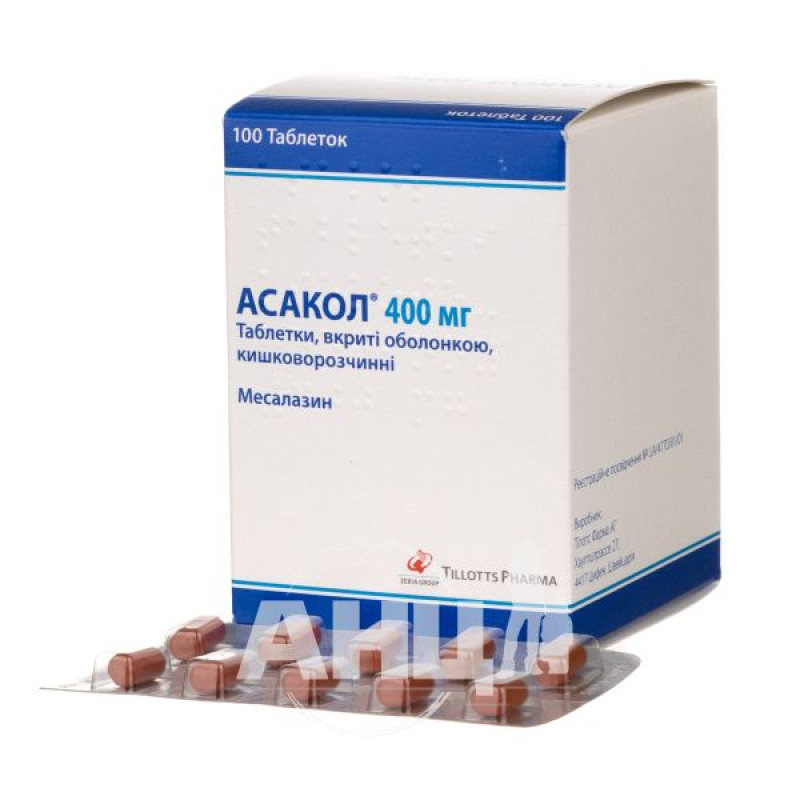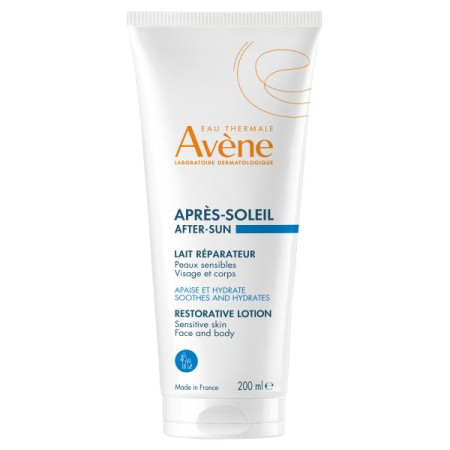Asacol enteric-coated tablets 400 mg blister No. 100

Instructions Asacol enteric-coated tablets 400 mg blister No. 100
Warehouse
active ingredient: mesalazine;
1 tablet contains 400 mg or 800 mg of mesalazine;
excipients: lactose monohydrate, sodium starch glycolate (type A), magnesium stearate, talc, povidone; shell: methacrylic copolymer (type B), talc, triethyl citrate, iron oxide yellow (E 172), iron oxide red (E 172), macrogol 6000.
Dosage form
The film-coated tablets are enteric-coated.
Main physicochemical properties: oblong, film-coated tablets, reddish to brownish in color.
Pharmacotherapeutic group
Anti-inflammatory drugs used in intestinal diseases. ATX code A07E C02.
Pharmacological properties
Pharmacodynamics.
The mechanism of anti-inflammatory action of mesalazine (5-aminosalicylic acid) is unknown. The results of studies indicate that mesalazine inhibits the migration of polymorphonuclear leukocytes and inhibits the activity of lipoxygenase, as a result of which the synthesis of anti-inflammatory leukotrienes in macrophages of the intestinal wall is suppressed. There is also evidence of the effect of mesalazine on the concentration of prostaglandins in the intestinal mucosa. Mesalazine can bind free radicals.
When administered orally, mesalazine acts mainly locally on the intestinal mucosa and submucosa from the intestinal cavity. It is therefore important that mesalazine is available in areas of inflammation. Systemic bioavailability and plasma concentrations are not essential for the therapeutic effect, but rather are a factor in safety.
Pharmacokinetics.
Asacol® tablets, coated with an enteric coating, are resistant to gastric juice. The polymer coating of the tablets ensures the release of the active substance depending on the pH of the environment in the lower ileum and colon, which are the main foci of inflammation. The composition of the tablets is selected in such a way as to minimize the absorption of mesalazine in the digestive tract. The absorption of mesalazine is highest in the proximal part of the intestine and lowest in its distal part. Absorption after oral administration is about 24%. Accordingly, 76% of the administered dose remains in the lower ileum and colon, as well as in the rectum, exerting a local anti-inflammatory effect.
Mesalazine is metabolized in the liver and intestinal mucosa to form the inactive metabolite N-acetyl-5-aminosalicylic acid. The binding of mesalazine and its metabolite to plasma proteins is 43% and 78%, respectively. Excretion occurs mainly with feces and urine in unchanged form and as a metabolite.
Indication
Mild to moderate nonspecific ulcerative colitis; supportive treatment in remission. Crohn's disease.
Contraindication
Hypersensitivity to the active substance, to any other component of the drug or to
salicylates; severe liver and kidney dysfunction (creatinine clearance < 30 ml/min); gastric and duodenal ulcer; hemorrhagic diathesis.
Interaction with other medicinal products and other forms of interactions
No specific drug interaction studies have been conducted.
When sulfasalazine and digoxin are used simultaneously, the absorption of digoxin is reduced. There are no data on the interaction of digoxin and mesalazine.
During combined treatment with mesalazine and azathioprine, 6-mercaptopurine or thioguanine, some studies have shown a higher incidence of myelosuppressive effects, which supposedly indicates the presence of an interaction, but the mechanism of interaction is not fully established. It is recommended to conduct regular monitoring (once a week) of blood parameters, in particular the number of leukocytes, platelets and lymphocytes, especially at the beginning of combination therapy. If the number of leukocytes remains stable during the first month of treatment, it is sufficient to conduct the study every 4 weeks for the next 12 weeks, after which the interval is increased to 3 months.
The dosage regimen of thiopurines should be adjusted.
There is evidence that mesalazine may reduce the anticoagulant effect of warfarin.
Concomitant use with nephrotoxic drugs such as NSAIDs, azathioprine or methotrexate may increase the risk of adverse renal reactions. However, adverse effects that may indicate such an interaction have not been reported.
Possible enhancement of the hypoglycemic effect of sulfonylurea derivatives, toxic effects of methotrexate. The activity of furosemide, spironolactone, sulfonamides, rifampicin, uricosuric drugs (probenecid and sulfinpyrazone) may be weakened.
Application features
Kidney dysfunction
The drug is not prescribed to patients with severe renal impairment.
It is recommended to monitor renal function for all patients before starting treatment with Asacol®, as well as during treatment according to the following scheme: 14 days after the start of therapy, then 2-3 more times with
at 4-week intervals. In the absence of signs of renal dysfunction, the tests are repeated every six months, and after 5 years of therapy - once a year. If other laboratory or clinical signs of renal dysfunction appear, the tests must be performed urgently. In the event of signs of renal dysfunction, the patient should immediately stop treatment with Asacol® and urgently consult a doctor.
Blood dyscrasia
Very rarely, cases of blood dyscrasia have been reported. If blood dyscrasia is suspected or present (signs of bleeding of unknown origin, hematoma, purpura, anemia, prolonged fever, and complaints of sore throat), the patient should immediately stop treatment with Asacol® and consult a doctor urgently. Before starting and during treatment, blood tests should be performed - it is recommended to conduct a control 14 days after the start of treatment, then 2-3 more times at 4-week intervals. If the results of the tests are normal, routine checks are sufficient every 3 months. If other additional symptoms develop, tests should be performed urgently.
It is especially important to monitor the blood picture if the patient develops the following symptoms during treatment: bleeding of unknown origin, hematoma, purpura, anemia, prolonged fever, and complaints of sore throat. In such cases, treatment should be stopped immediately and the patient should be provided with the necessary medical care.
Hypersensitivity to sulfasalazine
If the patient has hypersensitivity to sulfasalazine, treatment should be carried out only under constant medical supervision and immediately discontinued if signs of acute intolerance to the drug develop, such as cramps, abdominal pain, fever, severe headache, and skin rashes.
Liver dysfunction
Elevated liver enzymes have been reported in patients taking mesalazine-containing products. Asacol® should be used with caution in patients with liver damage.
Before and during treatment, blood tests (liver function tests such as ALT or AST) should be performed, the date of which is determined by the doctor. It is recommended that such tests be performed within 14 days of the start of treatment, and then 2-3 times at 4-week intervals. If the results are normal, the tests are repeated every three months. If additional symptoms occur, additional tests should be performed immediately.
Cardiac hypersensitivity reactions
Isolated cases of cardiac hypersensitivity reactions (myo- or pericarditis) caused by mesalazine have been reported with Asacol®. Asacol® should not be re-administered to patients with a history of cardiac hypersensitivity caused by mesalazine. The drug should be used with caution in patients with a history of allergic myo- or pericarditis, regardless of the drug that caused the reaction.
Stomach or duodenal ulcer
If the patient has a stomach or duodenal ulcer, the use of Asacol® is contraindicated.
Presence of pills in stool
There have been isolated reports of whole tablets in the stool. In the vast majority of cases, these are remnants of the tablet shell. If whole tablets are frequently found in the stool, the patient should consult a doctor.
Lung disease
Patients with lung diseases, particularly asthma, should be under medical supervision during treatment with mesalazine.
Elderly patients
The drug should be prescribed with caution to elderly patients only if normal renal function is maintained.
Carbohydrate intolerance
The drug contains lactose, so it should not be prescribed to patients with rare hereditary forms of galactose intolerance, lactase deficiency or glucose-galactose malabsorption syndrome.
Use during pregnancy or breastfeeding
There are no adequate data from the use of Asacol® in pregnant women. Limited data indicate no adverse effects of mesalazine on pregnancy or on the health of the fetus and/or newborn. However, some data indicate an increased risk of premature birth and reduced birth weight. One case of renal failure in a newborn has been reported after prolonged use of high-dose mesalazine by the mother during pregnancy (2-4 g per day).
Thus, the drug can be prescribed during pregnancy only when the expected benefit to the mother outweighs the potential risk to the fetus.
N-acetyl-5-aminosalicylic acid and, to a lesser extent, mesalazine are excreted in breast milk. There is currently only limited experience with the use of the drug in women during breastfeeding. Hypersensitivity reactions, such as diarrhea, cannot be excluded. Therefore, Asacol® tablets should only be used during breastfeeding if the potential benefit outweighs the possible risk. If diarrhea develops in a breastfed infant, breastfeeding should be discontinued.
Asacol® tablets should not be used in children under 6 years of age, as experience with the use of the drug in this age group is insufficient.
Ability to influence reaction speed when driving vehicles or other mechanisms
No effect on the ability to drive or use machines was observed, but the possibility of side effects such as dizziness should be taken into account.
Method of administration and doses
Adults
Ulcerative colitis.
When treating the disease in the acute phase, the dose is selected individually and is up to 4 g of mesalazine per day, divided into several doses.
For maintenance treatment in remission, the recommended dose is up to 2 g of mesalazine once a day, selected individually. The dose can also be divided into several doses.
Crohn's disease.
When treating the disease in the acute phase and as maintenance therapy, the dose is selected individually and is up to 4 g of mesalazine per day, divided into several doses.
Elderly patients do not require dose adjustment unless renal function is impaired.
Children aged 6 and over
In the treatment of ulcerative colitis and Crohn's disease in the acute stage, the dose should be selected individually, starting from 30-50 mg/kg body weight/day, divided into several doses. The maximum dose is
· 75 mg/kg body weight/day, divided into several doses. The total daily dose should not exceed 4 g of mesalazine.
· In maintenance therapy, the dose should be selected individually, starting from 15-30 mg/kg body weight/day, divided into several doses. The total daily dose should not exceed 2 g of mesalazine.
As a rule, children weighing up to 40 kg are given half the adult dose, and children weighing more than 40 kg are given the full adult dose.
Tablets should be taken whole, without chewing, with sufficient liquid, 1 hour before meals. Both during exacerbation of the disease and during maintenance treatment in the remission stage, to achieve the desired therapeutic effect, Asacol® tablets should be taken regularly and continuously. The duration of use is determined by the doctor. Usually, remission in ulcerative colitis and Crohn's disease occurs after 8-12 weeks of taking Asacol®.
Children.
Asacol® tablets should not be used in children under 6 years of age, as experience with the drug in this age group is insufficient.
Overdose
To date, no cases of intoxication and specific antidotes have been reported.
If necessary, perform intravenous infusion of electrolytes (forced diuresis).
Adverse reactions
Adverse reactions are classified according to frequency of occurrence: very common (≥ 1/10), common (≥ 1/100, < 1/10), uncommon (≥ 1/1000, < 1/100), rare (≥ 1/10000, < 1/1000), very rare (< 1/10000), isolated cases.
Disorders of the hematopoietic and lymphatic systems
Uncommon: eosinophilia.
Very rare: altered blood counts (aplastic anemia, agranulocytosis, pancytopenia, neutropenia, leukopenia, thrombocytopenia), bone marrow depression, blood disorders.
Immune system disorders
Very rare: hypersensitivity reactions such as allergic exanthema, drug fever, erythematous rash, pancolitis, angioedema, lupus-like syndrome.
Nervous system disorders
Uncommon: paraesthesia.
Rare: headache, dizziness.
Very rare: peripheral neuropathy, benign intracranial hypertension (in children during puberty).
Cardiovascular system disorders
Rare: myocarditis, pericarditis.
Respiratory, thoracic and mediastinal disorders
Very rare: allergic and fibrosing pulmonary reactions (including dyspnoea, cough, bronchospasm, alveolitis, pulmonary eosinophilia, lung tissue infiltration, pneumonitis), pneumonia, interstitial lung disease, eosinophilic pneumonia, respiratory disorders.
Gastrointestinal disorders
Rare: abdominal pain, diarrhea, flatulence, nausea, vomiting, dyspepsia.
Uncommon: exacerbation of Crohn's disease or ulcerative colitis.
Very rare: acute pancreatitis.
Hepatobiliary system disorders
Very rare: changes in liver function parameters (increased transaminases and cholestatic enzymes), hepatitis, cholestatic hepatitis, hepatic failure.
Skin and subcutaneous tissue disorders
Common: skin rash.
Uncommon: urticaria, pruritus.
Very rare: alopecia.
Musculoskeletal, connective tissue and bone disorders
Very rare: myalgia, arthralgia.
Frequency not known: Lupus-like syndrome with pericarditis and pleuropericarditis as the main symptoms, as well as skin rash and arthralgia.
Renal and urinary disorders
Very rare: renal dysfunction, including acute and chronic interstitial nephritis and renal failure, nephrotic syndrome, renal failure, which sometimes normalizes after drug withdrawal.
Reproductive system and mammary gland disorders
Very rare: oligospermia (reversible).
Frequency unknown: increased plasma creatinine, decreased body weight, decreased creatinine clearance, increased amylase concentration, increased erythrocyte sedimentation rate, increased lipase concentration, increased blood urea nitrogen.
Expiration date
3 years.
Do not use after the expiry date stated on the packaging.
Storage conditions
Store at a temperature not exceeding 25 °C in the original packaging.
Keep out of reach of children.
Packaging
400 mg tablets: 10 tablets in a blister; 10 blisters in a cardboard box;
800 mg tablets: 10 tablets in a blister; 5 or 6 blisters in a cardboard box.
Vacation category
According to the recipe.
Producer
Tillotts Pharma AG.
Location of the manufacturer and its business address
Hauptstrasse 27, 4417 Ziefen, Switzerland.
There are no reviews for this product.
There are no reviews for this product, be the first to leave your review.
No questions about this product, be the first and ask your question.
















